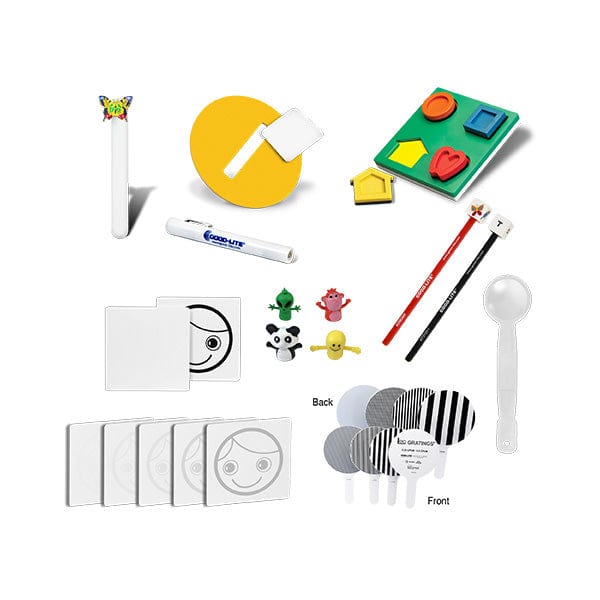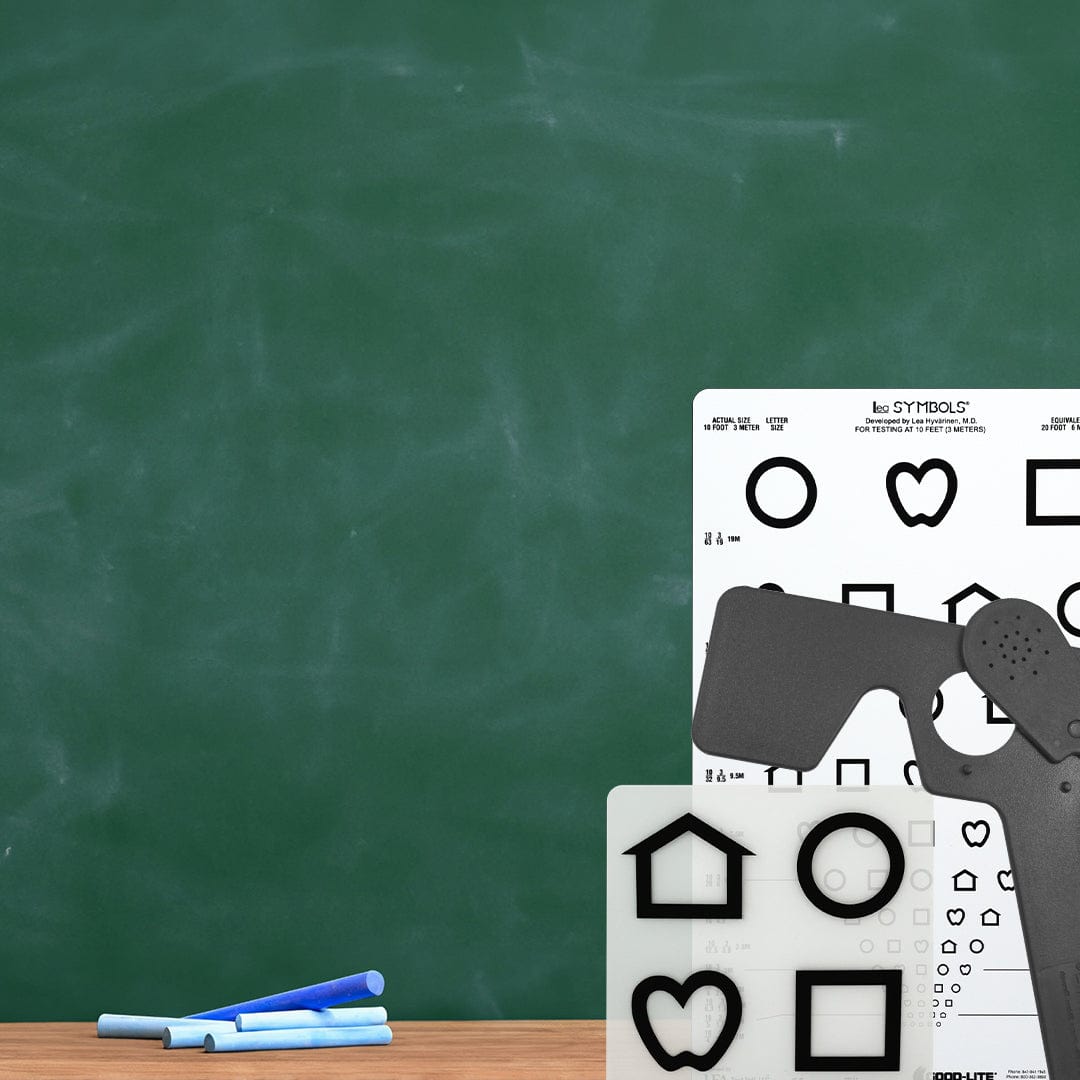

About
The Early Intervention Screening Kit is designed to help assess and monitor vision development in children under the age of 5. The tools provided are based on feedback from industry leading professionals, and adhere to the Good-Lite quality standard. The kit includes:
251600 - The LEA 3-D PUZZLE®
Designed to support the development of the concept of "same," first with colors, then with black & white concrete forms that are prerequisites for the measurement of recognition acuity with the LEA SYMBOLS® tests at an early age. During play, you can also observe eye-hand coordination and awareness of direction which are often problems for children with brain damage, even mild brain damage.
731011 - BLACK HANDLE FIXATION CUBE
An HOTV cube with a center HOTV optotype calibrated to 20/40 (6/12) and an outer HOTV optotype calibrated to 20/200 (6/60) equivalent when tested at 16" (40 cm) on top of the cube. The HOTV optotypes on side of the cube are calibrated to 20/125 (6/38) equivalent.
256300 - 256300 RED HANDLE FIXATION CUBE
A combination LEA SYMBOLS® and pediatric pictures cube with a central LEA SYMBOLS® optotype on top calibrated to 20/40 (6/12) at 16” (40 cm) and an outer LEA SYMBOLS® optotype calibrated to 20/200 (6/60) equivalent when tested at 16" (40 cm).
254700 - LEA MAILBOX GAME®
This game is used to assess the visual perception of line orientation. Tests two components:
- Information for the hand movements in the parietal lobe and
- Picture perception in the inferior temporal lobe.
To observe the first function, the child is asked to drop a card through the slot of the LEA MAILBOX GAME®. The child should demonstrate the perception of the orientation of the slot by turning the card to the correct position before moving it half the distance to the slot (dorsal stream function). A ventral stream function can be observed through interactive play using the LEA MAILBOX GAME®. If a child cannot visually perceive the orientation of lines, drawing them may be difficult, and drawing angles will make no sense.
253510 - HIDING HEIDI LOW CONTRAST FACE TEST
Visual communication is the most important communication method during the first year of life. The ability to detect objects of low contrast is an important component of the visual system. For example, facial expressions are mediated by faint shadows and changes in the contours of the mouth and eyes. Determining the levels of contrast that an infant can detect helps provide baseline data for evaluating future changes. For example, deviations from usual behavior may indicate disorders that leave vision at high contrast levels unaffected.
542085 - BUTTERFLY FLASHING FIXATION STICK
A Butterfly Flashing Fixation Stick that provides a series of detailed accommodation-stimulation targets for young patients. This stick can be used to perform various kinds of tests. Consists of a durable plastic stick with fixation flashers.
495000 - ASSORTED FINGER PUPPETS
Capture any child's attention with these assorted finger puppets as near point fixation targets. Easily fits on the end of your finger or over your transilluminator. CHARACTERS MAY VARY.
760000 - FROSTED 'SEE THE EYE' OCCLUDER
A frosted occluder that provides occlusion for the patient while allowing observation of the eye. Recommended for use with pediatric patients.
Single penlight SINGLE PENLIGHT
A penlight is essential for examining eye movements.
253300 - LEA GRATINGS® a Preferential Looking Test
LEA GRATINGS® are for preferential looking test situations with infants or children and adults with disabilities to determine detection acuity. Grating levels printed on each handle are: 0.25, 0.5, 1.0, 2.0, 4.0 and 8.0 cpcm (cycles per centimeter of surface). Includes instructions, a storage case, and 4 paddles. Dimensions: Width: 7.75" x 12.5" (19.685 cm x 31.75 cm).
The Early Intervention Screening Kit is designed to help assess and monitor vision development in children under the age of 5. The tools provided are based on feedback from industry leading professionals, and adhere to the Good-Lite quality standard. The kit includes:
251600 - The LEA 3-D PUZZLE®
Designed to support the development of the concept of "same," first with colors, then with black & white concrete forms that are prerequisites for the measurement of recognition acuity with the LEA SYMBOLS® tests at an early age. During play, you can also observe eye-hand coordination and awareness of direction which are often problems for children with brain damage, even mild brain damage.
731011 - BLACK HANDLE FIXATION CUBE
An HOTV cube with a center HOTV optotype calibrated to 20/40 (6/12) and an outer HOTV optotype calibrated to 20/200 (6/60) equivalent when tested at 16" (40 cm) on top of the cube. The HOTV optotypes on side of the cube are calibrated to 20/125 (6/38) equivalent.
256300 - 256300 RED HANDLE FIXATION CUBE
A combination LEA SYMBOLS® and pediatric pictures cube with a central LEA SYMBOLS® optotype on top calibrated to 20/40 (6/12) at 16” (40 cm) and an outer LEA SYMBOLS® optotype calibrated to 20/200 (6/60) equivalent when tested at 16" (40 cm).
254700 - LEA MAILBOX GAME®
This game is used to assess the visual perception of line orientation. Tests two components:
- Information for the hand movements in the parietal lobe and
- Picture perception in the inferior temporal lobe.
To observe the first function, the child is asked to drop a card through the slot of the LEA MAILBOX GAME®. The child should demonstrate the perception of the orientation of the slot by turning the card to the correct position before moving it half the distance to the slot (dorsal stream function). A ventral stream function can be observed through interactive play using the LEA MAILBOX GAME®. If a child cannot visually perceive the orientation of lines, drawing them may be difficult, and drawing angles will make no sense.
253510 - HIDING HEIDI LOW CONTRAST FACE TEST
Visual communication is the most important communication method during the first year of life. The ability to detect objects of low contrast is an important component of the visual system. For example, facial expressions are mediated by faint shadows and changes in the contours of the mouth and eyes. Determining the levels of contrast that an infant can detect helps provide baseline data for evaluating future changes. For example, deviations from usual behavior may indicate disorders that leave vision at high contrast levels unaffected.
542085 - BUTTERFLY FLASHING FIXATION STICK
A Butterfly Flashing Fixation Stick that provides a series of detailed accommodation-stimulation targets for young patients. This stick can be used to perform various kinds of tests. Consists of a durable plastic stick with fixation flashers.
495000 - ASSORTED FINGER PUPPETS
Capture any child's attention with these assorted finger puppets as near point fixation targets. Easily fits on the end of your finger or over your transilluminator. CHARACTERS MAY VARY.
760000 - FROSTED 'SEE THE EYE' OCCLUDER
A frosted occluder that provides occlusion for the patient while allowing observation of the eye. Recommended for use with pediatric patients.
Single penlight SINGLE PENLIGHT
A penlight is essential for examining eye movements.
253300 - LEA GRATINGS® a Preferential Looking Test
LEA GRATINGS® are for preferential looking test situations with infants or children and adults with disabilities to determine detection acuity. Grating levels printed on each handle are: 0.25, 0.5, 1.0, 2.0, 4.0 and 8.0 cpcm (cycles per centimeter of surface). Includes instructions, a storage case, and 4 paddles. Dimensions: Width: 7.75" x 12.5" (19.685 cm x 31.75 cm).
Good-Lite Early Intervention Screening Kit
- Regular price
- $520.00
- Sale price
- $520.00
- Regular price
-
$520.00
SKU: 350006
About
The Early Intervention Screening Kit is designed to help assess and monitor vision development in children under the age of 5. The tools provided are based on feedback from industry leading professionals, and adhere to the Good-Lite quality standard. The kit includes:
251600 - The LEA 3-D PUZZLE®
Designed to support the development of the concept of "same," first with colors, then with black & white concrete forms that are prerequisites for the measurement of recognition acuity with the LEA SYMBOLS® tests at an early age. During play, you can also observe eye-hand coordination and awareness of direction which are often problems for children with brain damage, even mild brain damage.
731011 - BLACK HANDLE FIXATION CUBE
An HOTV cube with a center HOTV optotype calibrated to 20/40 (6/12) and an outer HOTV optotype calibrated to 20/200 (6/60) equivalent when tested at 16" (40 cm) on top of the cube. The HOTV optotypes on side of the cube are calibrated to 20/125 (6/38) equivalent.
256300 - 256300 RED HANDLE FIXATION CUBE
A combination LEA SYMBOLS® and pediatric pictures cube with a central LEA SYMBOLS® optotype on top calibrated to 20/40 (6/12) at 16” (40 cm) and an outer LEA SYMBOLS® optotype calibrated to 20/200 (6/60) equivalent when tested at 16" (40 cm).
254700 - LEA MAILBOX GAME®
This game is used to assess the visual perception of line orientation. Tests two components:
- Information for the hand movements in the parietal lobe and
- Picture perception in the inferior temporal lobe.
To observe the first function, the child is asked to drop a card through the slot of the LEA MAILBOX GAME®. The child should demonstrate the perception of the orientation of the slot by turning the card to the correct position before moving it half the distance to the slot (dorsal stream function). A ventral stream function can be observed through interactive play using the LEA MAILBOX GAME®. If a child cannot visually perceive the orientation of lines, drawing them may be difficult, and drawing angles will make no sense.
253510 - HIDING HEIDI LOW CONTRAST FACE TEST
Visual communication is the most important communication method during the first year of life. The ability to detect objects of low contrast is an important component of the visual system. For example, facial expressions are mediated by faint shadows and changes in the contours of the mouth and eyes. Determining the levels of contrast that an infant can detect helps provide baseline data for evaluating future changes. For example, deviations from usual behavior may indicate disorders that leave vision at high contrast levels unaffected.
542085 - BUTTERFLY FLASHING FIXATION STICK
A Butterfly Flashing Fixation Stick that provides a series of detailed accommodation-stimulation targets for young patients. This stick can be used to perform various kinds of tests. Consists of a durable plastic stick with fixation flashers.
495000 - ASSORTED FINGER PUPPETS
Capture any child's attention with these assorted finger puppets as near point fixation targets. Easily fits on the end of your finger or over your transilluminator. CHARACTERS MAY VARY.
760000 - FROSTED 'SEE THE EYE' OCCLUDER
A frosted occluder that provides occlusion for the patient while allowing observation of the eye. Recommended for use with pediatric patients.
Single penlight SINGLE PENLIGHT
A penlight is essential for examining eye movements.
253300 - LEA GRATINGS® a Preferential Looking Test
LEA GRATINGS® are for preferential looking test situations with infants or children and adults with disabilities to determine detection acuity. Grating levels printed on each handle are: 0.25, 0.5, 1.0, 2.0, 4.0 and 8.0 cpcm (cycles per centimeter of surface). Includes instructions, a storage case, and 4 paddles. Dimensions: Width: 7.75" x 12.5" (19.685 cm x 31.75 cm).
The Early Intervention Screening Kit is designed to help assess and monitor vision development in children under the age of 5. The tools provided are based on feedback from industry leading professionals, and adhere to the Good-Lite quality standard. The kit includes:
251600 - The LEA 3-D PUZZLE®
Designed to support the development of the concept of "same," first with colors, then with black & white concrete forms that are prerequisites for the measurement of recognition acuity with the LEA SYMBOLS® tests at an early age. During play, you can also observe eye-hand coordination and awareness of direction which are often problems for children with brain damage, even mild brain damage.
731011 - BLACK HANDLE FIXATION CUBE
An HOTV cube with a center HOTV optotype calibrated to 20/40 (6/12) and an outer HOTV optotype calibrated to 20/200 (6/60) equivalent when tested at 16" (40 cm) on top of the cube. The HOTV optotypes on side of the cube are calibrated to 20/125 (6/38) equivalent.
256300 - 256300 RED HANDLE FIXATION CUBE
A combination LEA SYMBOLS® and pediatric pictures cube with a central LEA SYMBOLS® optotype on top calibrated to 20/40 (6/12) at 16” (40 cm) and an outer LEA SYMBOLS® optotype calibrated to 20/200 (6/60) equivalent when tested at 16" (40 cm).
254700 - LEA MAILBOX GAME®
This game is used to assess the visual perception of line orientation. Tests two components:
- Information for the hand movements in the parietal lobe and
- Picture perception in the inferior temporal lobe.
To observe the first function, the child is asked to drop a card through the slot of the LEA MAILBOX GAME®. The child should demonstrate the perception of the orientation of the slot by turning the card to the correct position before moving it half the distance to the slot (dorsal stream function). A ventral stream function can be observed through interactive play using the LEA MAILBOX GAME®. If a child cannot visually perceive the orientation of lines, drawing them may be difficult, and drawing angles will make no sense.
253510 - HIDING HEIDI LOW CONTRAST FACE TEST
Visual communication is the most important communication method during the first year of life. The ability to detect objects of low contrast is an important component of the visual system. For example, facial expressions are mediated by faint shadows and changes in the contours of the mouth and eyes. Determining the levels of contrast that an infant can detect helps provide baseline data for evaluating future changes. For example, deviations from usual behavior may indicate disorders that leave vision at high contrast levels unaffected.
542085 - BUTTERFLY FLASHING FIXATION STICK
A Butterfly Flashing Fixation Stick that provides a series of detailed accommodation-stimulation targets for young patients. This stick can be used to perform various kinds of tests. Consists of a durable plastic stick with fixation flashers.
495000 - ASSORTED FINGER PUPPETS
Capture any child's attention with these assorted finger puppets as near point fixation targets. Easily fits on the end of your finger or over your transilluminator. CHARACTERS MAY VARY.
760000 - FROSTED 'SEE THE EYE' OCCLUDER
A frosted occluder that provides occlusion for the patient while allowing observation of the eye. Recommended for use with pediatric patients.
Single penlight SINGLE PENLIGHT
A penlight is essential for examining eye movements.
253300 - LEA GRATINGS® a Preferential Looking Test
LEA GRATINGS® are for preferential looking test situations with infants or children and adults with disabilities to determine detection acuity. Grating levels printed on each handle are: 0.25, 0.5, 1.0, 2.0, 4.0 and 8.0 cpcm (cycles per centimeter of surface). Includes instructions, a storage case, and 4 paddles. Dimensions: Width: 7.75" x 12.5" (19.685 cm x 31.75 cm).





